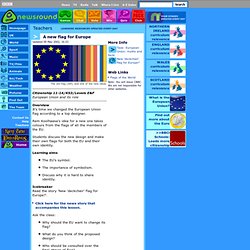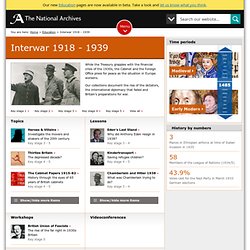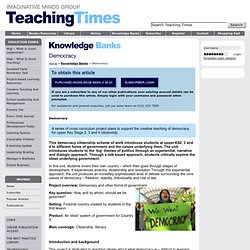

British Declaration of War (audio and transcript of Chamberlain's speech) CBBC - Newsround - What is The Cabinet? Citizenship KS2/KS3/Levels E&F Central government Prime Minister David Cameron on the left, Nick Clegg on the right Overview Prime Minister David Cameron gets to pick a team of ministers.

He must form a cabinet of about twenty people. Students decide which posts would make up a cabinet to run their school, then they see how this compares to the posts needed to run the country. Learning aims What is meant by a cabinet Some key posts Cabinet responsibility Icebreaker What is the cabinet? Can the group name any of the politicians who help David Cameron run the country? Explain that: Prime Ministers work with a cabinet. A school cabinet Students pick a cabinet to run their school. The cabinet members The cabinet members can be anyone, celebrities, sports stars, politicians, business people etc. The cabinet posts Let the students decide what the posts will be: e.g. Main activity Now compare to the real thing How many of these areas of responsibility did they include in their list? Extension activity Plenary. A new flag for Europe.
Ask the class: Why should the EU want to change its flag?

What do you think of the proposed design? Who should be consulted over the final choice of flag? Main activity Students design their own flags to represent the European Union. Their flags should stick to the traditional rectangular shape. They should add a written explanation of why they chose particular design features as if they were presenting their idea to the European Commission. They should explain their choice of: shapes colours images Extension activity Students working in groups of four design a flag to represent their group.
They should include representations of their lives. Hobbies they have sports they like favourite books and films their family and friends The finished flag must be agreed upon by all members. They should be prepared to explain their flags to the rest of the class. If possible students present their designs to the class. Democracy or dictatorship? Interwar 1918 - 1939. While the Treasury grapples with the financial crisis of the 1930s, the Cabinet and the Foreign Office press for peace as the situation in Europe worsens.

Our collections document the rise of the dictators, the international diplomacy that failed and Britain's preparations for war. Topics Heroes & Villains Investigate the movers and shakers of the 20th century Key stage 3 - 5 Thirties Britain The depressed decade? A series of cross curriculum project plans to support the creative teaching of democracy for upper Key Stage 2, 3 and 4 citizenship. – Knowledge Banks – Imaginative Minds.
This democracy citizenship scheme of work introduces students at upper KS2, 3 and 4 to different forms of government and the values underlying them.

The unit introduces students to the ‘big’ themes of politics through an experiential, narrative and dialogic approach. Through a talk based approach, students critically explore the ideas underlying government. In this unit, students invent their own country – which then goes through stages of development. It experiences anarchy, dictatorship and revolution Through this experiential approach, the unit produces an incredibly sophisticated level of debate surrounding the core values of democracy – freedom, stability, individuality and rule of law. Project overview: Democracy and other forms of government Key question: How, and by whom, should we be governed? Setting: Fictional country created by students in the first lesson. Product: An ‘ideal’ system of government for Country X. Main coverage: Citizenship, literacy Introduction and background 3a 3b.